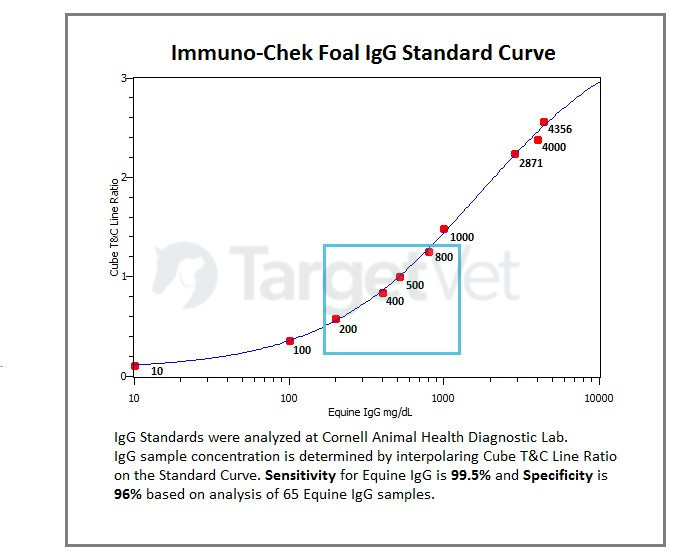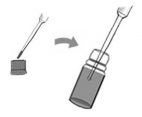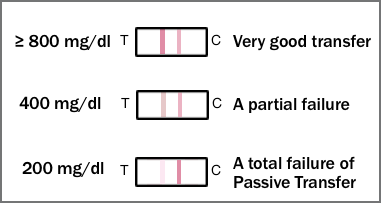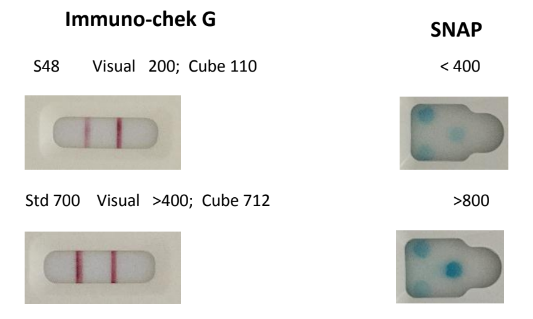Healthy foals are priceless.
Quickly identify immunodeficient foals with IgG testing.
Armed with no antibodies, foals are naturally at risk for infection and disease. Immunoglobulin (IgG) testing is used to quickly and accurately detect low IgG levels in order to immediately begin treatment of immunodeficient foals before serious complications arise. TargetVet's Immuno-Chek G™ testing is more sensitive and accurate than SNAP testing and results are easier to read.
Benefits.
Our diagnostic products provide important data on the equine reproductive cycle including:
- Test on-site and get results in ten minutes.
- Tests are easy to use and interpret.
- Test IgG and treat low levels immediately.
- No refrigeration required.
- Tests remain accurate and reliable over their long shelf life (2+ years).
IgG Validation
The Immuno-Chek G foal IgG test is a sandwich type Lateral flow test (LF). Two specific antibodies for equine IgG are put on membrane and bound to the IgG in the equine sample. It is well known that Sandwich assays do not cross react with molecules such as albumin and fibrinogen which make the Immuno-Chek G foal IgG test very accurate. Cross reactivity is a big problem with Turbidimetric assays. Big molecules like albumin and fibrinogen aggregate at the same time when measuring IgG; thus erroneously giving higher IgG concentration values.
TargetVet/Biometallics has done extensive in house testing to determine the sensitivity and specificity of the Immuno-Chek G foal IgG test. Standards and controls are used to optimize every lot of Foal IgG. After every lot is optimized, fresh equine samples are tested and compared to Cornell results which uses a Turbidimetric Immunoassay (TIA).

Immuno-Chek G™ vs. SNAP Foal IgG
| Foal ID | Cube Reader Immuno-Chek G™ Lateral Flow (mg/dl) |
Visual Immuno-Chek G™ Lateral Flow (mg/dl) |
SNAP ELISA Protocol (mg/dl) |
Lab Densimeter Turbidimetric Assay (mg/dl) |
|---|---|---|---|---|
| M20 | 1003 | > 800 | > 800 | |
| Std 400 | 404 | 400 | < 400 | 400 |
| Std 200 | 219 | 200 | < 400 | 200 |
| Std 500 | 506 | 400 | < 400 | 500 |
| Std 700 | 712 | 400 - 800 | > 800 | 700 |
| S48 | 110 | 200 | < 400 | 150 |
Notes:
- Immuno-Chek G™ has better sensitivity than SNAP.
- SNAP does not give accurate results on samples between 400 - 800 mg/dl.
- SNAP results are difficult to read.
How to run an IgG test.
A. Obtain blood sample and run IgG test.
Step 1

Add 10 µL whole blood (or 5µL sera) to a dilution bottle and mix.
Step 2

With new tip add 10 µL from the diluted sample in the dilution bottle to the cassette.
Step 3

Add 3 drops from buffer B bottle.
Step 4
Wait 10 minutes.
B. Examine IgG test results.
Visual
Cassette Visual result

By examining the line intensities one can determine the need for supplementation. When test line intensity is much greater than control line intensity, this indicates a very good transfer (> 800 mg/dl). When the test and control lines have similar intensities, this indicates a partial failure (400 mg/dl). A weak test line compared to the control line indicates a total failure (200 mg/dl).
Quantitative
Cube reader result

The Equine Cube Reader generates a numerical value result (in mg/dl) by interpreting the line intensities based on an internal standard curve.
Visual result examples for Immuno-Chek G™ vs. SNAP.


A 840 mg/dl and 420mg/dl Equine IgG stds were measured on 8 Immuno-Chek G tests. Every cassette was read 8 times with Cube Reader for a total of 32 readings per std. The average concentration of the 840mg/dl was 843 ± 31mg/dl . The average concentration of the 420mg/dl was 427 ±15 mg/dl .
The results are much more accurate and sensitive than turbidemetric- densimeter technology. Typical densimeter result for a 600mg/dl std was 596± 81 mg/dl.
Proven Accuracy and Reliability
Dr. Karen Wimbush at Ohio State University has done a comparison study using Immuno-Chek G foal IgG. She concluded that the Immuno-Chek G foal IgG is very accurate and easy to use. The result data file is shown above and the entire results are linked here: Comparison IgG OSU.pdf
Immuno-Chek G foal IgG is a Quantitative test when used with the Cube Reader - for every sample run, you get a numerical value.
The optical electronic sensor of the Cube reader takes multiple high resolution scans of test and control line intensities to get accurate results. Using the test and control line intensities and the mathematical information (standard curve) on the calibration card, the Cube Reader calculates and displays the IgG concentration (mg/dL).
- The % CV of different readings on the same cube is 1-3 %
- The % CV between different cubes is < 3 %.
- The % CV with same sample on different cassettes is < 3 %
The reproducibility of Immuno-Chek G Foal IgG is very high and we have been selling the Cube Reader + Foal IgG test for over 6 years with great success. Numerous clinics and universities are using the Immuno-Chek G Foal IgG Test. We are confident in our product and if you experience any problems or questions; we are happy to provide great customer support.
Below is IgG feedback from some of our customers:
Amanda N. Bradbery, PhD. Assistant professor Equine Science Department of Animal Science and Range Science. Montana State University: “The immune-Chek G Foal IgG test kits with cube reader worked incredibly well for our herd at the Montana State University(2023) and for teaching students.”
Dr. Rodney Belgrave, DVM. Director of Internal Medicine Mid-Atlantic Equine Medical Center: “We have been successfully using the Immuno-Chek G kits for several years with accurate number results.”
Karen Vagnoni, PhD Immunobiology. Professor Cal Poly Animal Science Department: “Following foaling, we had random students try each test on a single sample and provide feedback. Your product was found to be the most user friendly and top-rated IgG checking test. This resulted in us switching to your product.”
Browse our store for equine testing products.

